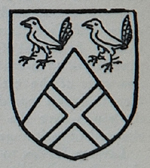A History of the County of Hertfordshire Volume 4 - Layston pages 77 to 88

The manor of BEAUCHAMPS alias MANORS ALFLADEWICK (Alfledawiche, xi cent.; Alflatesworth, Alfladewyk, xii cent.) was held by Godid, a 'man' of Asgar the Staller, in the time of Edward the Confessor.(47) In 1086 it had become part of the large possessions of Count Eustace of Boulogne, and was held of him by Rumold.(48) Count Eustace appears to have granted this fee with other lands either to his illegitimate son Geoffrey or to Geoffrey's son William of Boulogne,(49) who appears as overlord of Beauchamps shortly before his death in 1130.(50) He was succeeded by his son Faramus of Boulogne,(51) whose daughter and heir Sybil married Ingelram de Fiennes.(52) Ingelram de Fiennes was killed in battle in 1189. His son William de Fiennes was his heir(53) and appears as overlord of Beauchamps early in the 13th century.(54) After this date there is no further record of this family holding any rights in Beauchamps. They had apparently granted the services from this fee to one of the Vere family,(55) for Aubrey de Vere Earl of Oxford was returned as holding a fee in Alfladewick of the honour of Boulogne in 1210(56) and his successors are found as overlords of the manor.(57)
In 1129 Alfladewick was held in demesne by Rumold, either the Rumold of 1086 or his son.(58) This Rumold had two sons, Payn and Bernard, one of whom, apparently Bernard,(59) married the sister of Hugh son of Wulfgar, and half Alfladewick and half the mill with the land attached to it were granted to Hugh by Rumold and his sons as his sister's dower.(60) The manor appears to have remained in Rumold's family for some time, though the descent is difficult to trace. In 1191 Robert Rumold was holding one knight's fee in Alfladewick,(61) and in the 13th century reference is made to the mill of Rumold,(62) but there is no evidence to show if this family(63) was then holding the manor, the history of which cannot be traced until the end of the 13th century, when it was held by the family of Beauchamp. Henry de Beauchamp styled of Alfladewick was living in 1278,(64) and in 1303 the manor was held by Peter de Beauchamp.(65) His son John de Beauchamp was assessed at 18d. for his goods in Alfladewick in 1307-8,(66) but the greater part of the Beauchamps' lands appear by this time to have been conveyed to William de Foley, who was assessed at 3s. at the same date.(67) In 1325 Margery widow of Peter de Beauchamp quitclaimed to William Poley of Buntingford all right in the lands which he held in Alfladewick of the gift of Peter de Beauchamp and his son John.(68) By 1420 the 'tenement called Beauchamps' had come to Joan Waleys, widow of John Waleys of Glynde. She died seised of it in that year and her lands descended to her four daughters and co-heirs, Beatrice, Joan, Agnes and Joan.(69) Beauchamps was inherited by Agnes, who was holding it with her husband John Burgh in 1434(70) and with her second husband John Patington in 1452.(71) Agnes died in that year and the manor descended to her daughter Joan the wife of Ralph Grey, jun.,(72) of Brent Pelham.(73) Joan was left a widow and became the wife of Edward Goldesborough.(74) She died in 1496 and Beauchamps passed to her granddaughter by her first marriage, Elizabeth Grey.(75) Elizabeth married Anthony the third son of Sir William Walgrave, kt., of Smallbridge, in Bures St. Mary co. Suffolk.(76) She died before 1552, in which year her husband and her second son Julian were holding the manor,(77) the reversion of which was settled on Julian.(78)
In 1567 Anthony Walgrave conveyed the manor to William Naylor for the purpose of a grant to Edward Baesh,(79) William Walgrave, eldest son of Anthony and Elizabeth, quitclaiming his right to Edward Baesh and Thomasine his wife.(80) Edward with his second wife Jane, the daughter of Ralph Sadleir,(81) settled the manor in 1579 on their second son William, with remainder to their eldest son Ralph.(82) Edward Baesh died in 1587.(83) His son William probably predeceased him, as he was succeeded by Ralph,(84) who held Beauchamps until his death in 1598, when it descended to his son Edward Baesh.(85) The latter died without issue in 1653, and the manor apparently passed to his cousin Ralph Baesh (86) and was sold by him to John Taylor, afterwards rector of Westmill (87), who was holding it in 1669.(88) A conveyance of that date to Edward Smith may have been in trust for Bernard Turner, who is said to have bought it from Taylor.(89) At Turner's death in 1696 Beauchamps descended to his son John, who gave it to his daughter Anne on her marriage with Thomas Crouch
47 VCH. Herts. 1, 321b Godid was a woman. |
60 Ibid. |
71 See ibid. 31 Hen. VI, no. 161. 72 Chan. Inq. p.m. 31 Hen. VI, no. 17, 73 Visit, of Essex (Harl. Soc), i, 122. 74 See Chan. Inq. p.m. (Ser. 2), xii, 70a. 75 Ibid. 76 Visit, of Essex (Harl. Soc), i, 122, 309. 77 Feet of F. Herts. East. 6 Edw. VI. 78 See Com. Pleas D, Enr. Mich. 9 & 10 Eliz. m. 23. 79 Ibid. Julian's interest disappears. 80 Feet of F. Herts. Mich. 9 & 10 Eliz. 81 Visit, of Herts. (Harl. Soc), 125. 82 Com. Pleas D. Enr. Trin. 21 Eliz.m. 7 d. 83 Chan. Inq. p.m. (Ser. 2), ccxv, 269. 84 Ibid. 85 Ct. of Wards, Feod. Surr. 17. 86 For descent of the family of Baesh see the manor of Stanstead Abbots, Braughing Hundred. 87 Chauncy, Hist. Antiq. of Herts. 133. 88 Feet of F. Herts. Mich. 21 Chas. II 89 Chauncy, loc. cit. |
 | Select page number: Page 82 |  |
